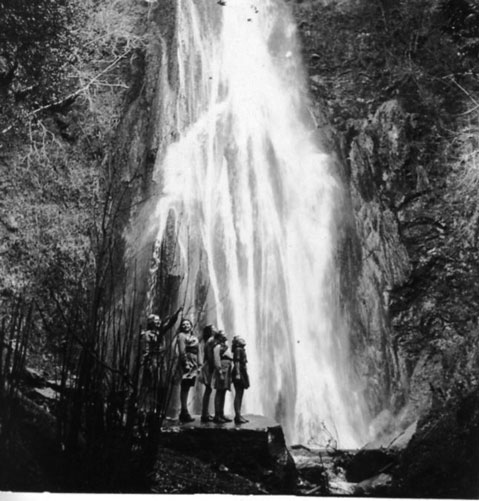Nojoqui Falls, just east of Highway 101 off of Alisal Road, is named after a Chumash village, “Naxuwi,” that was once near here. The modern name is pronounced Naw-ho-wee. The 164-foot falls, due to the vagaries of geography, is in one of the rainiest parts of the county. This, coupled with the presence of a natural spring, means the falls usually flows year-round.
There are two legends concerning the falls. The first recounts a terrible drought that caused the Native American Chumash of the area great suffering. The Chumash chief, calling upon the gods for assistance, staged an all-night prayer vigil. In the early hours of the morning, a beautiful woman appeared and led the chief to a fern-covered glen. The woman then arose into the air, and as she disappeared, her raiment turned into a glistening cascade of water. Thus Nojoqui Falls was born, and the drought was broken.

The second story tells of a Chumash band caught in a furious storm. Taking shelter in a cave to wait out the tempest, they heard cries for help coming from outside. Only a beautiful young maiden had the courage to venture forth and attempt a rescue. She returned with a warrior from another group who had been injured by a fallen tree.
The warrior was taken back to the village, and during his convalescence, he and the maiden fell in love, a situation looked upon with great distaste by other members of her tribe. Rumors of plots to do away with the warrior swirled through the village, and the young lovers determined to run away together. Relentlessly pursued, the couple was eventually trapped at the top of Nojoqui Falls. Rather than be torn asunder, they chose to die together and leapt into the abyss.
The known history of the area is somewhat more mundane. Nojoqui is generally accepted to mean “meadow.” During the era of Spanish rule, the Chumash village came under the purview of Mission La Purísima. Just to the north of the falls is Rancho Nojoqui, granted to Raymundo Carrillo in 1843 by the Mexican government. The rancho has been subdivided through the decades, the various portions passing through the hands of a number of owners. During the 1860s, when the stagecoach route went through Gaviota Pass, a relay station was established at Nojoqui. Between the station and Gaviota Pass, stages had to traverse the steep and difficult Nojoqui Grade. The station continued to service feeder lines after the primary stage route was established over San Marcos Pass.
The arrival of the railroad at Santa Barbara in 1887 and the growth of tourism raised hopes that the falls could become a major attraction. Some writers compared Nojoqui, with a bit of artistic license, to Yosemite Valley. The Southern Pacific Railroad, however, decided to stick to the coastal route, and the great development plans for Nojoqui never came to pass. Still, Nojoqui Falls County Park, this “Yosemite” of Santa Barbara County, is enjoyed by thousands of visitors every year.



